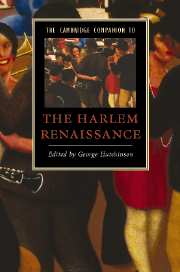Book contents
- Frontmatter
- Introduction
- Part I: Foundations of The Harlem Renaissance
- Part II: Major Authors and Texts
- 4 Negro drama and the Harlem Renaissance
- 5 Jean Toomer and the avant-garde
- 6 “To tell the truth about us”: the fictions and non-fictions of Jessie Fauset and Walter White
- 7 African American folk roots and Harlem Renaissance poetry
- 8 Lyric stars: Countee Cullen and Langston Hughes
- 9 “Perhaps Buddha is a woman”: women’s poetry in the Harlem Renaissance
- 10 Transgressive sexuality and the literature of the Harlem Renaissance
- 11 Sexual desire, modernity, and modernism in the fiction of Nella Larsen and Rudolph Fisher
- 12 Banjo meets the Dark Princess: Claude McKay, W. E. B. Du Bois, and the transnational novel of the Harlem Renaissance
- 13 The Caribbean voices of Claude McKay and Eric Walrond
- 14 George Schuyler and Wallace Thurman: two satirists of the Harlem Renaissance
- 15 Zora Neale Hurston, folk performance, and the “Margarine Negro”
- Part III: The Post-Renaissance
- Further Reading
- Index
15 - Zora Neale Hurston, folk performance, and the “Margarine Negro”
from Part II: - Major Authors and Texts
Published online by Cambridge University Press: 28 July 2007
- Frontmatter
- Introduction
- Part I: Foundations of The Harlem Renaissance
- Part II: Major Authors and Texts
- 4 Negro drama and the Harlem Renaissance
- 5 Jean Toomer and the avant-garde
- 6 “To tell the truth about us”: the fictions and non-fictions of Jessie Fauset and Walter White
- 7 African American folk roots and Harlem Renaissance poetry
- 8 Lyric stars: Countee Cullen and Langston Hughes
- 9 “Perhaps Buddha is a woman”: women’s poetry in the Harlem Renaissance
- 10 Transgressive sexuality and the literature of the Harlem Renaissance
- 11 Sexual desire, modernity, and modernism in the fiction of Nella Larsen and Rudolph Fisher
- 12 Banjo meets the Dark Princess: Claude McKay, W. E. B. Du Bois, and the transnational novel of the Harlem Renaissance
- 13 The Caribbean voices of Claude McKay and Eric Walrond
- 14 George Schuyler and Wallace Thurman: two satirists of the Harlem Renaissance
- 15 Zora Neale Hurston, folk performance, and the “Margarine Negro”
- Part III: The Post-Renaissance
- Further Reading
- Index
Summary
I'm going to sit here on this porch chair and prophesy that these are the last days of the know-nothing writers on Negro subjects.
Zora Neale Hurston, “You Don't Know Us Negroes”We almost lost Zora to the choose-between games played with Black art.
June Jordan, “Notes Toward a Balancing Act of Love and Hatred”“Magical Zora”
Magical Zora, our truth-telling fore-mother.
Ruth Sheffey, founder, The Zora Neale Hurston SocietyWhen an author's work is taught in colleges, and produced for television (by Oprah Winfrey), and her face graces postage stamps, coffee mugs, calendars, notecards, and refrigerator magnets, it is a safe bet that her status, in popular culture at least, is secure. Because so many of my friends and colleagues have bought them for me, I happen to own a great many Zora Neale Hurston finger puppet refrigerator magnets - complete with floppy hat, purple dress, pearl necklace, and “Magnetic Personalities” data card. Of the four dozen or so figures marketed in the magnet's celebrity series, Hurston is the only one identified by first name alone. This is not insignificant. Hurston has become a national celebrity and a folk heroine, as Sheffey's proclamation, quoted above, attests. Her intimacy with the shared heritage of folk traditions no doubt contributes to this sense that “Zora” is our familiar, someone we can approach on a first-name basis and imagine as our own. But, as I will suggest, there are myriad ironies involved in making Hurston into a folk heroine, not least of them being her own highly complex relation to the folk traditions she documented and referenced in almost everything that she wrote. This chapter, then, returns to some of Hurston's use of the folklore she collected to rethink the ways in which we have imagined her relationship to it.
- Type
- Chapter
- Information
- The Cambridge Companion to the Harlem Renaissance , pp. 213 - 236Publisher: Cambridge University PressPrint publication year: 2007
- 2
- Cited by



